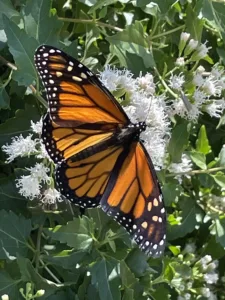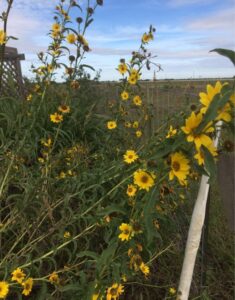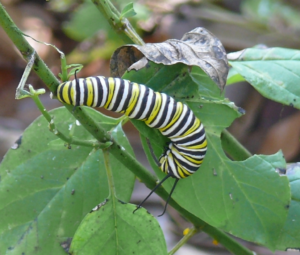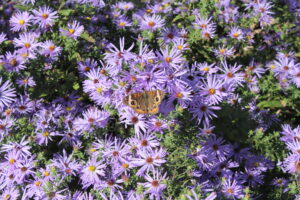Help us bring the Monarchs back to Texas!

Did you see the Monarchs migrating north in the spring? Or maybe you saw the Monarchs flying south through Texas to return to Mexico in the fall. If so, you might have noticed that there were fewer than there used to be. The Native Plant Society of Texas is doing its part to reverse this population decline.
Texas provides critical habitat on the main migration pathway to and from the Monarchs’ winter home in Mexico. The availability of milkweed and nectar plants has dropped sharply in Texas. Milkweeds act as host plants for Monarch caterpillars to eat and are essential to the Monarchs’ breeding success. Nectar plants are needed by adult butterflies to supply the energy to fly and lay eggs. Both are required for Monarchs to reproduce and migrate successfully.
Modern farming practices, pesticides, drought patterns, and the mowing and manicuring of roadsides, parks and open areas have all had a negative impact on the native plants Monarchs use and on the number of Monarchs surviving for the southbound journey to Mexico.
The Native Plant Society of Texas and Monarch Watch created the “Bring Back the Monarchs to Texas” (BBMT) program in a joint effort to educate members and the public about Monarch biology and conservation, to encourage propagation and distribution of native milkweeds that support Monarch reproduction, and to restore Monarch habitats throughout Texas.
Our annual BBMT grant program makes grants available to schools, nature centers and other organizations, to create additional Monarch habitat using native Texas plants.
Our BBMT committee also helps arrange in-person and remote education opportunities for all Texans on all aspects of Monarch biology and conservation, Monarch habitats, and gardening for Monarchs. To date, hundreds of Monarch garden habitats have been installed, and tens of thousands of people have attended our educational programs.
A Bring Back the Monarchs to Texas (BBMT) fund has been established to collect donations that fund the BBMT grant program and make other education and conservation efforts of the Bring Back the Monarchs to Texas committee possible.
Businesses, clubs, individuals, and Native Plant Society of Texas chapters can donate to the BBMT fund online or by sending a check to our NPSOT state office with a note designating the check for the BBMT fund.

Garden Grants
Monarch Garden Grants The Native Plant Society of Texas awards small grants to nature centers, schools, educational groups and others to help fund development of Monarch demonstration gardens or Monarch Waystations

Monarch & Milkweed Resources
Learn about Monarchs Learn about the Monarch Butterfly Learn about Milkweed Texas Parks and Wildlife Identification of Milkweeds (Illustrated Guide) Learn about Butterfly Gardens Wildflower Center guide to making

Monarch Waystation Requirements
Monarch Waystations are places that provide all the resources necessary for monarchs to produce successive generations and sustain their migration. A Monarch Waystation needs milkweeds, nectar plants, and some kind of
Frequently Asked Questions
From mid-November to February 1st, the current grant application can be downloaded here.
Contact us at bbmt@npsot.org or call our State Office at 830.997.9272. You can also look at our Speaker’s Bureau to find speakers and presentations about Monarchs.
Grant funds can only be spent for native plants and seeds of native plants. They may not be used for benches, rocks, signs, border materials, soil, amendments or other non-plant items.
They can also not be used for non-native plants. Under no circumstances can NPSPOT funds be used for Tropical Milkweed, Asclepias curassavica.
Most schools, community groups and garden clubs can qualify for a grant if their garden plan meets the requirements for a Monarch Waystation, and they are planning a garden in a public place. Monarch Waystations need three basic things: host plants (milkweeds), nectar plants, and some kind of dense plant for shelter.
Native Plant Society members, chapters and volunteers are encouraged to recruit and aid other organizations, schools and individuals to write grant applications. Though NPSOT chapter projects are eligible, they are not given special priority.
Our intent is to provide outreach and education to our communities in high visibility public locations. School gardens may be located in areas that the general public cannot access, since schools are considered to have a built-in population.
Yes, we will accept applications for additional plants for existing gardens.
Monarchs need two categories of plants to eat from, and also plants to help them hide.
- They need milkweed (various Asclepias species) to eat in the caterpillar stage. Got Milkweed? Monarchs need it to survive!
- They also need nectar plants to provide nutrition and energy in the mature stage. Some good native nectar plants include Liatris species, Maximilian Sunflower, Verbenas, Joe Pye Weed, Goldenrods, Purple Coneflowers and various “Mistflower” species, such as Gregg’s Mistflower and Shrubby Boneset.
- A dense shelter plant like a large clump grass or evergreen shrub is helpful to keep Monarchs safe in bad weather.
Check with your local native nurseries first. You could also raise native milkweed from seed. Native American Seed has a variety of native milkweed seed available. Many Native Plant Society and Texas Master Naturalist chapters have plant sales that may sell native milkweed.
Be sure that plants you buy from a nursery have not been treated with any pesticides, since these will kill Monarch larvae we are trying to help.
You may be able to order milkweed plugs through Monarch Watch’s Milkweed Market. All of the plants available through Monarch Watch will be species appropriate for your region. Some groups or individuals may qualify for free milkweed plugs. All of Monarchs Watch’s milkweed programs are described on their website here:
We have a short list of the more common native milkweeds here.
Texas Parks and Wildlife and the Lady Bird Johnson Wildflower Center have a booklet on Texas Milkweeds published online that can be downloaded here.
For the differences between Antelope Horns Milkweed and Green Milkweed, read here at Carol’s World.
Here’s more information on Antelope Horns from the Native Plant Society of Texas.


